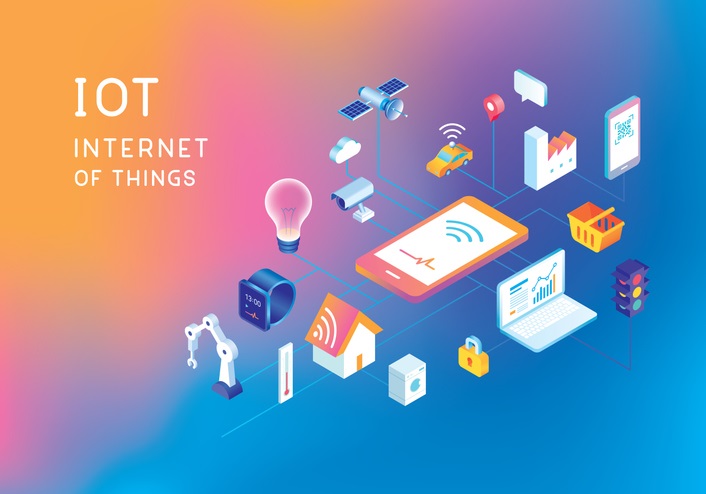A brief introduction to the technologies that allow consumer-facing integrations of software and logistics to be truly innovative and truly seamless. Read this article about Secure Integration Of IoT And Cloud Computing.
While IoT as a concept has been accessible in the public domain since the early eighties (available with Coca Cola vending machines that could track and update inventory status), the mainstream requirement for IoT application development took off post the astounding growth in cloud computing services, starting with the launch of the elastic computing cloud by Amazon in 2006.
IoT, for the uninitiated, refers to the “Internet of Things”, which can be further simplified as a network of devices or commonly used objects, that are connected, accessible, and operable via the internet. In the era of the consumer dotcom boom and subsequent technological breakthroughs, the applicability of IoT was limited to smart television sets, smart refrigerators, and similar devices. One could argue that the smartphone invention has really dampened chances for the evolution of IoT-specific devices such as augmented tablet devices, wearable computers, and more. However, that void in the IoT application development space was soon populated with a new requirement category altogether – the necessity to integrate IoT applications with “omnipresent” and scalable databases based on the cloud.
Why Was The IoT + Cloud Computing Integration Necessary?
The post-2010 boom in consumer-facing internet businesses saw the emergence of solutions that had never been imagined within a technological landscape earlier – eCommerce, consumer logistics, and other areas where the physical delivery of products and services, needed to be tracked, monitored and “presented” to users in a readable and engaging format, in real-time.
Think about what happens when you place an order on Amazon today, and the Prime service model delivers the package at your doorstep the next day. The application engine that powers this beautiful eCommerce interface processes the transaction and the purchase request on the cloud, which is then relayed to vendors and “service fulfilment” warehouses that procure, pack, and ship the order through necessary outlets. This involves filling facilities and machinery, the physical printing of shipping labels, the continuous tracking updates that must be available for you to check on your account (on either a web interface or the Amazon app on your smartphone), and much more, all the way till you receive the product, marking the service as “complete” and sending a return instruction to the servers that are monitoring the entire episode.
All of this would have taken a gargantuan amount of time in the age of manual intervention. But since cloud computing services began infiltrating this landscape, things have become remarkably more straightforward, thanks to the use of IoT devices such as label printing devices, product assembly lines, etc.
The Need For The Secure Integration of IoT and Cloud Computing
Consumer transactions are by definition, very socially fragile; it took a lot of effort by the communications teams acting on behalf of consumer corporations, to shift the mindset of users from a position of doubt to confidence. Starting from the initial days of eCommerce, consumers gradually learnt to trust online services where a credit card (or an internet banking service) could be authorised for use. Adding to such companies’ woes, data breaches and hacks have often been a pain point for both themselves and their users, affecting their reliability, security, and overall brand value.
It then became absolutely mandatory for organisations that integrate cloud computing services with IoT application development, to create and deploy certain tiers of security that would guard all the data that is being exchanged inside such an interface. Including private consumer data such as shipping addresses, contact information, purchase history, purchase preferences, banking details, credit card information (and most recently, virtual payment addresses, or UPI addresses).
According to a paper published on ResearchGate in 2016, one of the critical strengths of the IoT ecosystem is visible through its extremely high impact on some of the most important aspects of consumers’ daily life and behaviour. The apparent effects of the Internet of Things, as visible to a private user, are implicit in both domestic and professional spheres.
IoT security is directly tied in with the safeguarding of all connected devices and networks in the “Internet of things” loop that powers a consumer-facing ecosystem (eCommerce network or a consumer logistics/home-delivery service). These connected devices (“things”) must be assigned unique identifiers, and any exchange of information that takes place inside an IoT framework must be encrypted well enough to eliminate the possibility of a data breach, or the unauthorized use of consumer information for third-party gains.
Settling The Secure IoT + Cloud Debate
In the age of mobile-first computing, these advantages (and mandates) extend from the bubble of security, all the way into the more mappable and scalable domain of performance. Secure transmission of data translates into a faster relay of information. In other words, a truly seamless and secure IoT and Cloud Computing integration not only results in a safer system, but a faster system – one that users can learn to trust, love, and use loyally, ushering services and platforms into the desirable avenues of customer loyalty and repeat purchase behavior.










